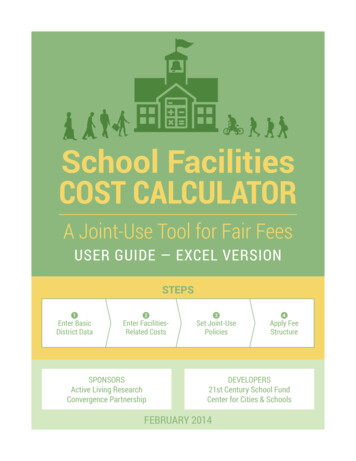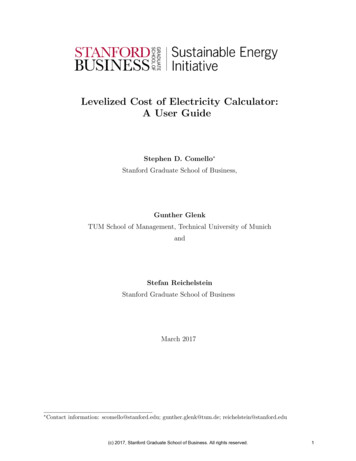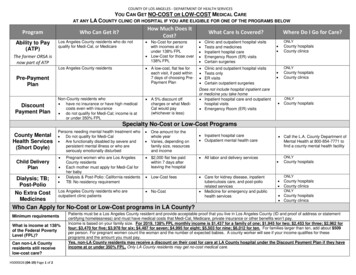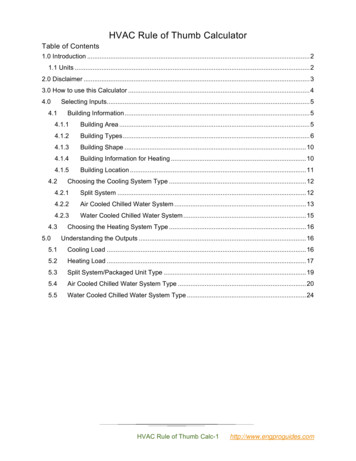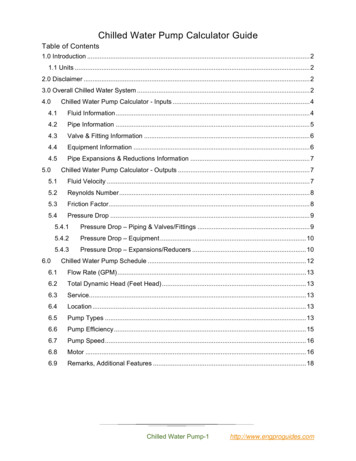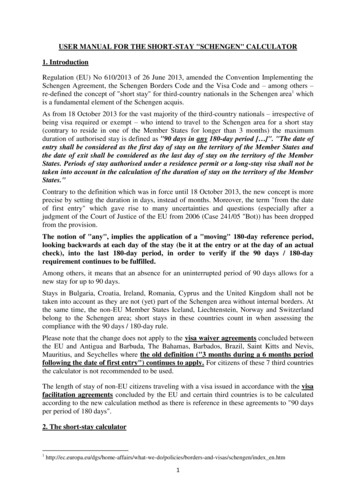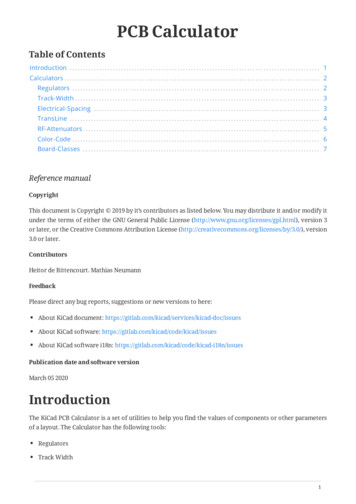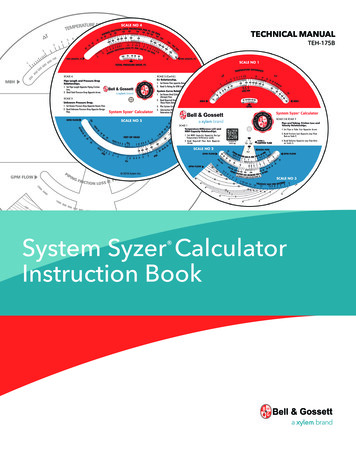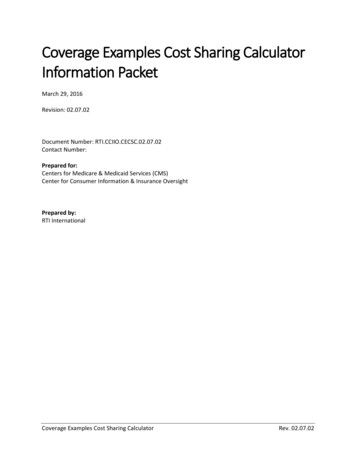
Transcription
Coverage Examples Cost Sharing CalculatorInformation PacketMarch 29, 2016Revision: 02.07.02Document Number: RTI.CCIIO.CECSC.02.07.02Contact Number:Prepared for:Centers for Medicare & Medicaid Services (CMS)Center for Consumer Information & Insurance OversightPrepared by:RTI InternationalCoverage Examples Cost Sharing CalculatorRev. 02.07.02
iiRevision HistoryRevisionDate02.04.XX.02 2/9/201602.05.XX.01 2/19/20162.07.023/29/2016RevisionsChanged references to “beneficiary” to “subscriber”Changed revision number to conform to version 02.05 of thecalculatorUpdated figure in §3.4 to reflect relabeling of buttons in toolAdded material to §Coverage Examples Cost Sharing CalculatorRev. 02.07.02
Table of ContentsRevision History . iiTable of Contents . iii1.0Purpose and Construction . 12.0Using the Coverage Examples Cost Sharing Calculator. 23.0Technical Overview . 23.13.23.33.43.53.63.74.04.14.24.34.45.05.15.2The WELCOME worksheet . 3The MANUAL INPUT Worksheet . 4The MULTIPLE PLAN MODE worksheet . 6The RESULTS SUMMARY worksheet . 7The MATERNITY SUMMARY, DIABETES SUMMARY and FRACTURE SUMMARY worksheets . 9The TIMELINE worksheets . 9The LINE ITEM worksheets. 15Plan Benefit Parameters and the BENEFIT DESIGN worksheet . 16Benefit Categories . 17Cost Sharing Options . 18Coverage limits. 20Out-of-pocket Limits . 20Multi-Plan Mode . 23Browsing and reviewing Multi-Plan Mode input data . 24Generating output in Multi-Plan Mode . 24Appendix A: Overview of the Coverage Examples Calculator Logic . 25Phase 1: Obtain the allowed amount . 25Phase 2: Determine whether the claim is for a covered service . 25Phase 3: Apply the monthly and annual coverage limits . 25Phase 4: Apply the required Co-payment or Co-insurance . 26Phase 5: Apply the required deductible. 26Phase 6: Apply the out-of-pocket limit . 26Phase 7: Calculate the subscriber and the plan payment . 27Phase 8: Allocate the subscriber payment to summary aggregation categories . 27Appendix B: PLAN INPUT DATA external data file specifications . 29Appendix C: PLAN OUTPUT DATA external data file. 35Coverage Examples Cost Sharing CalculatorRev. 02.07.02
Coverage Examples Cost Sharing Calculator1.0Purpose and ConstructionThe Coverage Examples Cost Sharing Calculator (CECSC) is a tool that can be used by health plans toestimate the out-of-pocket expenditure under a benefit package for treatment of three stylizedexamples: management of stable type 2 diabetes; an uncomplicated pregnancy with a vaginal birth; anda simple foot fracture.This coverage example calculator makes several assumptions which may not be valid for all plan designs.The coverage example calculator makes the following assumptions: The benefit package covers maternity care, diabetes care, and simple fracture care. If the plan doesnot cover these conditions, the coverage example calculator cannot be used for the non-coveredcondition;Consumer out-of-pocket costs do not include premiums.The condition was not excluded as a pre-existing condition.The only medical expense incurred by the subscriber was for treatment of the specified condition.There are no medical expenses for any member covered under the plan or policy other than thoselisted.The calculator treats each condition independently of the others. (For example, the calculator doesnot calculate the subscriber’s out-of-pocket cost if she is both diabetic and experiences anuncomplicated fracture.)All care is in-network and considered first tier (or the tier associated with the lowest level of costsharing), for those products that incorporate tiered provider networks.All services occur in same policy period.All prior authorizations are obtained.All services are deemed medically necessary.All costs (allowed amount, sample care costs, member costs) greater than 100 are rounded to thenearest hundred dollars.All costs (allowed amount, sample care costs, member costs) less than 100 are rounded to thenearest ten dollars.All medications are covered as generic equivalents if available.If the plan has a wellness program that varies the deductibles, copayments, coinsurance, orcoverage for any of the services listed in a treatment scenario, the benefit design that is appliedreflect the cost-sharing required assuming that the patient does NOT participate in the wellnessprogram.If your plan design differs significantly from these assumptions, the estimated consumer out-of-pocketcost may be inaccurate. In such a case, the user can alter the coverage calculator to make it moreaccurate. For example, if your plan covers diabetes supplies under the prescription drug benefit, a usercan modify the calculator to apply prescription drug cost sharing to those items. Alternatively, the plancan use a coverage calculator that it develops using as inputs the schedules of services provided and theschedule of allowed amounts that are included in the cost sharing calculator.The CECSC is a macro-enabled Excel workbook. The user must enable macros.Coverage Examples Cost Sharing CalculatorRev. 02.07.02
2.0Using the Coverage Examples Cost Sharing Calculator2.0Using the Coverage Examples Cost Sharing Calculator2The CECSC can be used in two different modes. When the workbook is first opened, the WELCOMEworksheet is displayed and Mode is selected.In the Single Plan Mode a user enters the characteristics of a single plan, and then runs the results ofthe calculator. In Single Plan Mode a user can also add plans one at a time and then export an output filefor all of the plans that the user has entered.In the Multi-Plan Mode a user imports (or copies) data from an external file for a set of plans and thenruns the calculator to produce an output file. In Multi-Plan Mode a user can also browse and review theresults for each plan before creating the output file.3.0Technical OverviewThe CECSC has 4 core worksheets that the user interacts with: The WELCOME worksheet in which the user chooses either the Single Plan or Multi-Plan mode.The MULTIPLE PLAN MODE worksheet in which the user chooses the method that will be used toenter data for multiple plans.The BENEFIT DESIGN worksheet in which the user enters the benefit design parameters (i.e., type ofcost sharing, deductible amounts, coinsurance rates, copayment amounts, coverage limits, etc.)The RESULTS SUMMARY worksheet which displays the estimated cost-sharing under the specifiedbenefit design for each of the standardized coverage examples.From the RESULTS SUMMARY worksheet, the user can navigate to a set of three worksheets for each ofthe coverage examples. Specifically, from the Maternity Example section of the RESULTS SUMMARYworksheet the user can navigate to: The MATERNITY SUMMARY worksheet which shows the allowed amount, the amount of the planpayment, and the amount of the subscriber payment for the maternity coverage example.The MATERNITY TIMELINE worksheet which shows the claim-by-claim development of theconsumer cost sharing amount.The MATERNITY LINE ITEM worksheet which shows the allowed amount for each of the items andservices that are included in the coverage example.From the Diabetes Type 2 section of the RESULTS SUMMARY worksheet the user can navigate to: The DIABETES SUMMARY worksheet which shows the allowed amount, the amount of the planpayment, and the amount of the subscriber payment for the Type 2 Diabetes coverage example.The DIABETES TIMELINE worksheet which shows the claim-by-claim development of the consumercost sharing amount.The DIABETES LINE ITEM worksheet which shows the allowed amount for each of the items andservices that are included in the coverage example.From the Foot Fracture Example section of the RESULTS SUMMARY worksheet the user can navigate to:Coverage Examples Cost Sharing CalculatorRev. 02.07.02
3.0 Technical Overview3The FRACTURE SUMMARY worksheet shows the allowed amount, the amount of the plan payment,and the amount of the subscriber payment for the foot fracture coverage example.The FRACTURE TIMELINE worksheet which shows the claim-by-claim development of the consumercost sharing amount.The FRACTURE LINE ITEM worksheet which shows the allowed amount for each of the items andservices that are included in the coverage example.In addition to these worksheets, the CECSC has two worksheets that are used to store the input andoutput data when the tool is being used in multi-plan mode. The PLAN INPUT DATA worksheet which holds the benefit design parameters for each of the plansthat have been entered.The PLAN OUTPUT DATA worksheet which holds the output data for each of the plans that havebeen entered.Each of these worksheets is described in the following sections.3.1The WELCOME worksheetWelcome to the Coverage Examples Cost Sharing CalculatorAll insurer data entry fields are highlighted in orange.The Cost Sharing Calculator operates in two modes.Click the button that corresponds to the mode you want to use.Single Plan ModeThe user enters data for an individual plan and views the results.Multi-Plan ModeThe user loads data for multiple plans and runs the calculator.The user can then browse the results for the individual plans, savethe results to an external file, or copy and paste the results forthe individual plans to a separate worksheet.On the WELCOME worksheet, which displays when the tool is opened, the user will select either theSingle Plan Mode or the Multi-Plan Mode.To select the Single Plan Mode, click the Single Plan Mode button. The BENEFIT DESIGN worksheet willthen be displayed, allowing the user to enter the parameters for a single plan or multiple plans one at atime.To select the Multi-Plan Mode, click the Multi-Plan Mode button. The MULTIPLE PLAN MODEworksheet will then be displayed, allowing the user to select the method that will be used to load datafor multiple plans.Coverage Examples Cost Sharing CalculatorRev. 02.07.02
3.0Technical Overview43.2The MANUAL INPUT WorksheetPrev Plan1Single Plan ModeEnter or modify data for each plan.Data entry fields are highlighted in orange.Plan 1Benefit categoryInpatient Hospital Care (Facility)Other Facility ServicesEmergency Department (Facility)AmbulanceProfessional Services: Primary CareProfessional Services: Emergency DepartmentProfessional Services: SpecialistProfessional Services: Obstetric Care (Bundled)Professional Services: Procedures & OtherProfessional Services: Physical TherapyDiagnostic Services: RadiologyDiagnostic Services: LaboratoryPrescription Drugs: GenericPrescription Drugs: BrandedOver-the-counter DrugsPreventive Services & VaccinesDurable Medical EquipmentMedical SuppliesOver-the-counter Medical SuppliesOther Items & ServicesPlan DeductibleRx DeductibleDeductible CDeductible DIndividual Out-of-Pocket (OOP) LimitClear1 of 3Next PlanMulti-Plan ModeUpdateSave AsRun CalculatorCost sharing¹Type of cost sharing thatBenefitCoCoappliesDeductible payment insuranceNot CoveredNot CoveredNot CoveredNot CoveredNot CoveredNot CoveredNot CoveredNot CoveredNot CoveredNot CoveredNot CoveredNot CoveredNot CoveredNot CoveredNot CoveredNot CoveredNot CoveredNot CoveredNot CoveredNot CoveredCoverage LimitsOOPperlimitmonth per year applies? 0¹ The benefit-specific deductible, copayment amount, or coinsurance rate that determines consumer liabi
can modify the calculator to apply prescription drug cost sharing to those items. Alternatively, the plan can use a coverage calculator that it develops using as inputs the schedules of services provided and the schedule of allowed amounts that are included in the cost sharing calculator. The CECSC is a macro-enabled Excel workbook. The user must enable macros. Coverage Examples Cost .
